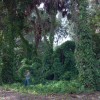 Air potato was introduced to Florida in 1905. By the 1980s, its vines were growing in thickets, waste areas, and hedges or fencerows in many parts of south and central Florida. By 1999, it was recognized as transforming plant communities by displacing native species, changing community structure and disrupting ecological functions. The air potato leaf beetle is a rather large, orange-red Asian leaf beetle. It feeds and develops only on air potato. The USDA-ARS Invasive Plant laboratory in Fort Lauderdale acquired this beetle from China and has begun an ambitious release program aimed at controlling air potato. This 3-page fact sheet was written by T. D. Center and W. A. Overholt, and published by the UF Department of Entomology and Nematology, October 2012.
Air potato was introduced to Florida in 1905. By the 1980s, its vines were growing in thickets, waste areas, and hedges or fencerows in many parts of south and central Florida. By 1999, it was recognized as transforming plant communities by displacing native species, changing community structure and disrupting ecological functions. The air potato leaf beetle is a rather large, orange-red Asian leaf beetle. It feeds and develops only on air potato. The USDA-ARS Invasive Plant laboratory in Fort Lauderdale acquired this beetle from China and has begun an ambitious release program aimed at controlling air potato. This 3-page fact sheet was written by T. D. Center and W. A. Overholt, and published by the UF Department of Entomology and Nematology, October 2012.
http://edis.ifas.ufl.edu/in957
Tag: Indian River REC
FA174 Teach Aquaculture Curriculum: Spawning and Rearing Bivalve Molluscs–Spawning
FA174, a 9-page activity by R. Leroy Creswell, Cortney L. Ohs, Craig S. Kasper, Elisa J. Livengood, Amber L. Garr, Brian E. Myers, Carlos V. Martinez, and Frank A. Chapman, is activity 12 of the Teach Aquaculture Curriculum. In this activity for grades 9-12, students will learn methods for spawning bivalve molluscs like clams or oysters using temperature manipulation. Students will use an ocular micrometer to measure the diameter of bivalve eggs and the length of bivalve larvae. Includes student performance standards. Published by the UF School of Forest Resources and Conservation, Program in Fisheries and Aquatic Sciences, May 2010.
http://edis.ifas.ufl.edu/fa174
AE248 Fertilizer Application Best Management Practices for Citrus Grove Workers
Revised! AE248, a 12-page fact sheet by Brian Boman, Darren Cole, Steve Futch, Ward Gunter, Jack Hebb, and Chris Wilson, instructs citrus grove workers in fertilizer application best management practices. Includes references and quizzes throughout. Published by the UF Department of Agricultural and Biological Engineering, March 2009.
http://edis.ifas.ufl.edu/ae248
AE244 Pesticide Safety and Personal Protective Equipment for Citrus Grove Workers
AE244, an 11-page fact sheet by Brian Boman, Darren Cole, Steve Futch, Ward Gunter, Jack Hebb, Chris Wilson, is part of the Best Management Practices (BMPs) for Citrus Grove Workers series. It provides information for citrus grove workers about toxicity and effects of exposure to pesticides and personal protective equipment. Includes two quizzes and references. Published by the UF Department of Agricultural and Biological Engineering, February 2009.
http://edis.ifas.ufl.edu/AE244
AE247 Pesticide Application Best Management Practices for the Citrus Grove Worker
AE247, an 15-page fact sheet by Brian Boman, Darren Cole, Steve Futch, Ward Gunter, Jack Hebb, Chris Wilson, is part of the Best Management Practices (BMPs) for Citrus Grove Workers series. It provides information for citrus grove workers about pests, pest control methods, pesticide toxicity,how to transport pesticides, first aid and decontamination, preventing exposure, worker protection standard, storage and disposal, pre-operation checkpoints, mixing and loading, container management, calibration, application best management practices . Includes three quizzes and references. Published by the UF Department of Agricultural and Biological Engineering, April 2009.
http://edis.ifas.ufl.edu/AE247
AE246 Herbicide Application Best Management Practices for Citrus Grove Workers
Revised! AE246, a 13-page illustrated fact sheet by Brian Boman, Darren Cole, Steve Futch, Ward Gunter, Jack Hebb, Chris Wilson, is part of the Best Management Practices (BMPs) for Citrus Grove Workers series. It covers personal protective equipment, tractor and herbicider preventive maintenance, mixing and loading, posting, important stepts to take before application, herbicide application, equipment clean up, and spill containment. Includes three comprehension quizzes and references. Published by the UF Department of Agricultural and Biological Engineering, March 2009.
http://edis.ifas.ufl.edu/AE246
ABE367/AE243 Understanding the Pesticide Label for Citrus Grove Workers
Revised! ABE-367, a 5-page fact sheet by Brian Boman, Darren Cole, Steve Futch, Ward Gunter, Jack Hebb, Chris Wilson, is part of the Best Management Practices (BMPs) for Citrus Grove Workers series. It emphasizes the importance of reading pesticide labels, the risks of misusing pesticides, and what is on the label. Includes a 10 question quiz and references. Published by the UF Department of Agricultural and Biological Engineering, March 2009.
http://edis.ifas.ufl.edu/AE243
SS-AGR-312/AG318 Natural Area Weeds: Invasive Solanum spp. in Florida
SS-AGR-312, a 7-page illustrated fact sheet by L. T. Markle, W. A. Overholt and K. A. Langeland, provides a guide to differentiate the invasive Solanum species, information about the ecology and management of each species, and information on Solanum capsicoides All., which can easily be confused with some of the invasive Solanum species. Includes references. Published by the UF Department of Agronomy, December 2008.
http://edis.ifas.ufl.edu/AG318